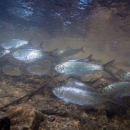What We Do
Fish and other aquatic species are declining at alarming rates across the globe and one of the biggest threats is habitat loss. The National Fish Habitat Partnership is a comprehensive effort to treat the causes of fish habitat decline, not just the symptoms.
The Partnership is a national investment strategy designed to maximize the impact of conservation dollars on the ground. Funds are leveraged through regional partnerships to address the nation’s biggest fish habitat challenges and projects are identified and completed through a network of 20 regional Fish Habitat Partnerships. These partnerships leverage federal, state, Tribal, and private resources to achieve the greatest impacts on conservation.
Since 2006, the USFWS has provided over $62.4 million to conservation projects which leveraged at a 4:1 ratio to provide over $320 million in funding support for fish habitat conservation projects that improve angling and recreational opportunities across the nation.
National Fish Habitat Partnership has implemented over 1,300 conservation projects spanning 50 states. National Fish Habitat Partnership conservation projects have reconnected more than 6,000 miles of rivers and streams, while conserving over 45,000 acres of river, lake riparian riparian
Definition of riparian habitat or riparian areas.
Learn more about riparian , upland, estuary and wetland habitat. In 2020, America’s Conservation Enhancement Act codified the National Fish Habitat Partnership program into law, helping to ensure this collaborative, partnership-driven, conservation program will continue to protect, restore, and enhance the Nation’s fish habitat into the future.
In 2024, the U.S. Fish and Wildlife Service and partners are providing more than $27.4 million to support 91 on-the-ground fish habitat conservation projects in 29 states. The Service is providing $5.9 million this year, with non-governmental organizations, state resource agencies, and other partners contributing, an additional $21.5 million. This represents a 3.6:1 leveraged funding match for National Fish Habitat Partnership funding.
The 20 National Fish Habitat Partnerships conserve fish habitat and enhance fishing by improving and sustaining our country's aquatic resources. These projects will boost and empower locally-led efforts to restore stream banks, remove barriers to fish passage fish passage
Fish passage is the ability of fish or other aquatic species to move freely throughout their life to find food, reproduce, and complete their natural migration cycles. Millions of barriers to fish passage across the country are fragmenting habitat and leading to species declines. The U.S. Fish and Wildlife Service's National Fish Passage Program is working to reconnect watersheds to benefit both wildlife and people.
Learn more about fish passage , reduce erosion from farm and ranchlands, and conduct monitoring and assessments to identify conservation needs for fish and their habitats. Anticipated benefits include more robust fish populations, better fishing, and healthier waterways.
How the National Fish Habitat Partnership program works.
The work is voluntary.
The National Fish Habitat Partnership program takes a voluntary, non-regulatory, approach to address the nation’s fish habitat conservation challenges.
Funding is leveraged to maximize results.
Under the National Fish Habitat Partnership, federal, state, Tribal, and privately raised funds are leveraged to address the nation’s biggest fish habitat challenges. In 2019, limited federal funding from the Service was leveraged by more than 3 to 1 with funds from other partners.
Conservation gains grow the economy and protect against climate.
The network of Fish Habitat Partnerships drive local job creation through direct funding investments and build more resilient infrastructure that can better withstand climate change climate change
Climate change includes both global warming driven by human-induced emissions of greenhouse gases and the resulting large-scale shifts in weather patterns. Though there have been previous periods of climatic change, since the mid-20th century humans have had an unprecedented impact on Earth's climate system and caused change on a global scale.
Learn more about climate change . Often, the same barriers that hurt fish, like undersized culverts in road crossings, can also harm communities. Undersized culverts can block fish passage and prevent them from being able to move freely to find food, shelter, and reproduce. They can also cause water to back up behind the crossing during storms, often leading to culvert failure and severe road damage.
Fish Habitat Partnership projects restore healthy fish populations, ecosystems, and the communities for the future!

